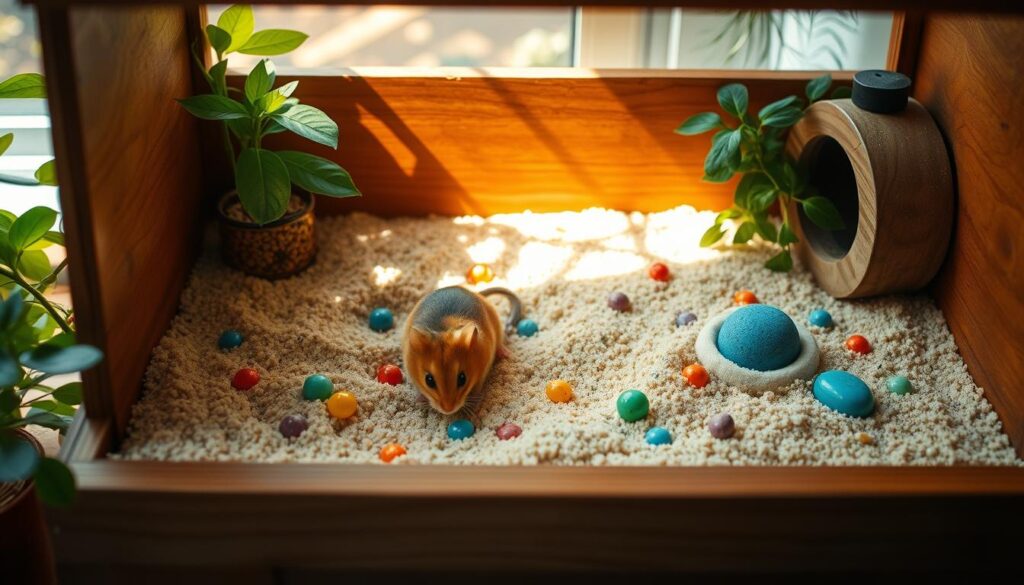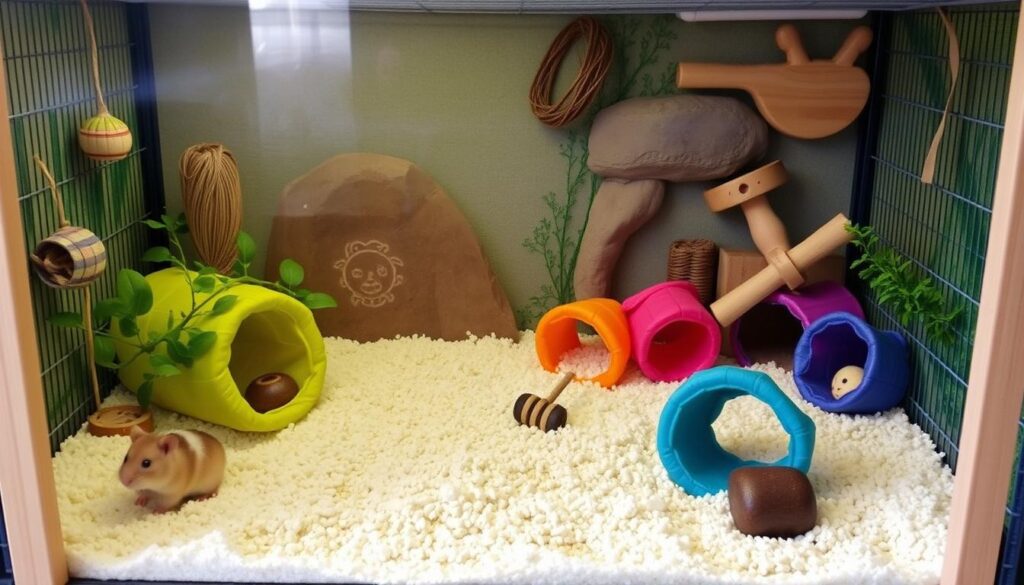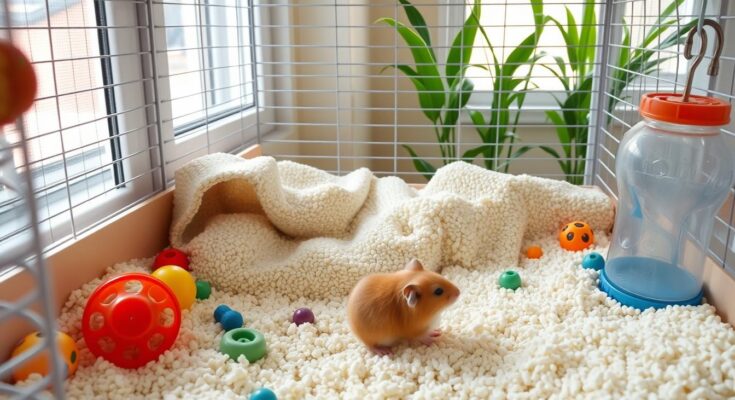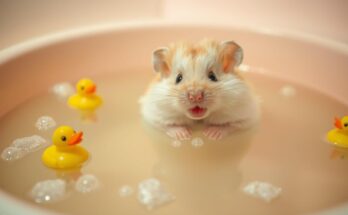Being a hamster parent is incredibly rewarding. Yet, one important thing to remember is the danger of bathing them. Water baths can be very harmful to hamsters. In this guide, I’ll share what every hamster owner needs to know to keep their pets safe and happy.
Key Takeaways
- Hamsters are naturally clean animals and don’t require frequent water baths.
- Bathing a hamster can strip their fur of essential oils, leading to skin irritation, stress, and potentially fatal illnesses.
- Proper hamster care involves providing a suitable environment, a balanced diet, and alternative cleaning methods like sand baths.
- Knowing when and how to safely clean a hamster is critical for their health and happiness.
- Keeping their habitat clean and comfortable is essential for a happy, healthy hamster.
Understanding Hamsters’ Natural Cleaning Habits
Hamsters are amazing little creatures known for their cleanliness. They spend a lot of time making sure their fur is spotless. They groom themselves by licking, nibbling, and scratching, all without water.
How Hamsters Keep Themselves Clean
Hamsters have special ways to clean themselves. Their flexible bodies let them reach every part of their fur. Their sharp teeth and quick paws help get rid of dirt and oils. They groom for up to an hour, keeping their fur sleek and healthy.
The Role of Natural Oils in Hamster Fur
Natural oils play a big part in hamsters’ grooming. These oils come from glands and protect their fur. They make the fur soft, shiny, and clean, without needing water baths.
Why Hamsters Don’t Need Water Baths
Hamsters don’t need water baths because they clean themselves so well. Water baths can be harmful to them. They can get stressed and their oils can cause skin problems.
By understanding hamsters’ natural grooming, we can keep them happy and healthy. Letting them groom themselves is the best way to care for them.
“Hamsters are remarkably efficient at keeping themselves clean through their natural grooming behaviors, rendering water baths unnecessary and potentially harmful.”
Can a Bath Kill a Hamster: The Risks Explained
Hamster owners need to be careful about giving their pets water baths. Bathing a hamster can be very risky and even deadly in some cases. We’ll look at the dangers of putting a hamster in water and why it’s best to avoid it.
Water baths can be very stressful for hamsters. They don’t like water and getting wet can cause a big stress reaction. This can lead to heart problems because of their small size and sensitive body.
Another big risk is hypothermia. Hamsters lose heat fast because they have a high metabolism and less body fat. Getting wet and cold can drop their body temperature too low, which is dangerous.
- Respiratory issues: Wet fur and skin can make it hard for a hamster to breathe. This can lead to infections and pneumonia.
- Skin problems: Wet fur can upset the natural oils in a hamster’s fur. This can cause skin irritation, fungal infections, and other skin issues.
- Drowning: Hamsters can drown in water baths because they can’t swim well or keep their heads up.
In short, the dangers of water baths for hamsters are too great. It’s important for pet owners to find safer ways to keep their hamsters clean and healthy.
| Risk | Explanation |
|---|---|
| Stress and Heart Attacks | Hamsters are highly susceptible to the stress of being submerged in water, which can trigger a severe stress response and potentially lead to a heart attack. |
| Hypothermia | Hamsters have a higher metabolic rate and lower body fat, making them vulnerable to rapid heat loss when wet, which can result in dangerous drops in body temperature. |
| Respiratory Issues | Wet fur and skin can impair a hamster’s ability to breathe properly, increasing the risk of respiratory infections and pneumonia. |
| Skin Problems | Prolonged wetness can disrupt the natural oil balance in a hamster’s fur, leading to skin irritation, fungal infections, and other dermatological issues. |
| Drowning | Hamsters lack the ability to effectively swim or keep their heads above water, putting them at risk of drowning during a water bath. |
With so many risks, it’s key for pet owners to avoid water baths for hamsters. Instead, they should find safer ways to keep their pets clean and healthy.
Safe Alternatives to Water Bathing
As pet owners, we must be careful with our hamsters. Water baths can be dangerous and even deadly for them. Luckily, there are safer ways to keep them clean and fresh.
Sand Bath Benefits and Setup
A sand bath is a great way to keep your hamster clean. Hamsters love to roll in dry sand to groom themselves. It helps remove oils from their fur.
To create a sand bath, use a shallow container or a sand bath box. Fill it with clean, calcium-free sand. Place it in a quiet spot in their habitat. This will encourage your hamster to enjoy their new bathing spot.
Choosing the Right Bathing Sand
Choosing the right sand is key. Avoid sands with calcium or additives. Instead, use natural, unscented sands made for small animals or reptiles. This keeps your hamster safe and comfortable.
Creating an Effective Sand Bath Area
The size and location of the sand bath matter. Make sure it’s big enough for your hamster to move around but not too deep. Place it in a quiet area to encourage use without stress.
With a well-designed sand bath, your hamster can stay clean and healthy. It’s a safer alternative to water baths. The right setup and materials will keep your furry friend happy and well-cared for.

Signs Your Hamster Needs Cleaning
Keeping your hamster clean is key to their health. As a pet owner, it’s important to know when your hamster needs a clean. Here are some signs that your hamster might need some grooming:
- Matted or oily fur: If your hamster’s fur looks clumped or greasy, they need help.
- Strong odor: A bad smell from your hamster means they need a clean-up.
- Visible dirt or debris: Seeing dirt or dust in your hamster’s fur means it’s time to groom.
- Sticky substances: Sticky stuff on your hamster’s fur needs quick attention for hamster hygiene.
Watching your hamster closely is key to keeping them clean. By noticing and fixing hygiene issues early, you keep your hamster healthy and happy.
“Proper hamster hygiene is essential for their overall well-being. Keep a close eye on your pet’s appearance and act quickly if you notice any signs that they need a little extra cleaning attention.”
Preventing problems is the best way to keep your hamster’s coat clean. A clean home, good food, and regular grooming help a lot. By being proactive, you can help your hamster live a long, healthy life.
| Indicator | Explanation |
|---|---|
| Matted or Oily Fur | A sign that the hamster’s self-grooming is insufficient, and they may need assistance to maintain their coat. |
| Strong Odor | A strong, unpleasant odor can indicate a need for cleaning or a possible health issue. |
| Visible Dirt or Debris | Visible dirt, dust, or other debris in the fur is a clear sign that the hamster needs cleaning. |
| Sticky Substances | Any sticky substances on the coat should be addressed promptly to maintain the hamster’s hygiene. |
Emergency Cleaning Situations: What to Do
As pet owners, we must be ready for unexpected emergencies with our hamsters. If your hamster gets into a mess or shows signs of distress, act fast. We’ll cover what to do in hamster emergency cleaning situations and when to see a veterinary care professional.
Dealing with Soiled Fur
If your hamster gets dirty, clean the area gently. Use a damp, soft cloth to wipe the fur. Don’t soak your hamster in water, as it can be scary and harmful. After removing dirt, dry the area with a clean towel.
Handling Sticky Substances
For sticky situations, a bit of unscented baby oil can help. Apply a small amount to the sticky area and use a soft cloth to remove it. Be careful not to use too much oil, as it could harm your hamster.
When to Seek Veterinary Help
If cleaning doesn’t work or your hamster gets worse, see a vet right away. Your vet can figure out what’s wrong and treat it. They might need to do special cleaning, give medicine, or do other things. Always call your vet for help to keep your hamster safe and healthy.
Preventing messes is the best way to keep your hamster’s home clean. Clean their cage often, groom them well, and watch for problems. Being proactive and quick to act will keep your hamster happy and healthy.
Temperature and Environmental Considerations
Keeping your hamster’s environment comfortable and stable is key. The best temperature for their home is between 65-75°F (18-24°C). Make sure they don’t get too hot or cold, as this can harm their health.
Good airflow is also important. Make sure their cage has enough air to keep it fresh. This helps keep the air and temperature right for your hamster.
- Maintain a consistent temperature between 65-75°F (18-24°C) in your hamster’s habitat.
- Protect your hamster from drafts and sudden temperature changes.
- Ensure the enclosure has proper ventilation to prevent respiratory issues.
Creating a stable and comfy temperature control space is vital. Hamsters are very sensitive to their surroundings. So, always check and adjust their home to keep them happy and healthy.

“Providing the right temperature and environmental conditions is critical for your hamster’s well-being. Ignoring these can cause serious health issues.”
Proper Grooming Tools and Techniques
Keeping your hamster clean and well-groomed is key to being a good pet owner. Hamsters usually take care of their own cleanliness. But, the right grooming tools and techniques can make their coat look great.
Safe Brushing Methods
For grooming, use a soft-bristled brush made for small animals. Brush your hamster’s fur gently in the direction it grows. This removes loose hair and keeps their fur shiny and healthy.
Spot Cleaning Recommendations
For spot cleaning, a damp cloth or unscented baby wipe works well. Use it to clean dirt, debris, or sticky stuff from their fur. Always be gentle to avoid stressing your hamster.
Hamsters are delicate, and grooming is important for their health. With the right tools and techniques, your hamster will look and feel their best.
Creating a Healthy Habitat for Clean Hamsters
Keeping your hamster’s home clean and big is key to their health. Start with a cage that’s at least 450 square inches. Use safe bedding like paper or aspen shavings. Clean the cage often to get rid of dirty bedding and droppings.
Cleaning your hamster’s cage fully once a week is a must. Hamsters can get sick if their home smells bad. This can lead to serious diseases. So, cleaning regularly helps keep them healthy.
- Spot-clean the cage daily by removing pee-soiled spots, checking and refilling water, and removing leftover food.
- Wash water bowls or bottles thoroughly and provide fresh water twice a week.
- Weekly tasks include wiping/washing shelves, washing the wheel if it’s peed on, cleaning the nest, and emptying and refilling the sand in the potty.
- For sand baths, if the hamster pees in it, spot-clean it, and replace the sand fully once a month if needed.
When you’re cleaning the whole habitat, take your hamster to a safe place first. Use a disinfectant like F10SC Veterinary Disinfectant. It kills bacteria and viruses well.
“Regular maintenance and cleaning are essential for keeping your hamster healthy and happy in their habitat.”
By keeping your hamster’s home clean and big, you help them stay healthy. A regular cleaning schedule is important for a happy hamster.
Common Cleaning Mistakes to Avoid
Keeping your hamster’s home clean is key for their health. But, it’s vital to use the right cleaning products and methods. Here are some mistakes to avoid when caring for your furry friend.
Dangerous Cleaning Products
Using harsh household cleaners is a big mistake. These can be toxic to hamsters and harm their health. Stay away from products with strong smells, like bleach or air fresheners. Choose safe cleaning products made for small animal habitats instead.
Improper Handling During Cleaning
Be gentle when cleaning your hamster’s cage. Avoid grabbing or restraining them to prevent stress or injury. Gently pick them up, supporting their whole body, and put them in a safe place while you clean.
By avoiding these common mistakes, you can keep your hamster’s home clean and safe. This will help them stay happy and healthy.
Special Care for Different Hamster Species
Each hamster species has its own needs. This includes the right housing and grooming habits. It’s important to meet these specific needs to keep your hamster healthy and happy.
Roborovski Dwarf Hamsters
Roborovski dwarf hamsters are small and very active. They need big sand baths for their grooming. This helps keep their fur clean and healthy.
Syrian Hamsters
Syrian hamsters, also known as golden hamsters, are very popular pets. They like to have their own space because they can get aggressive if they’re together. It’s important to give them a big cage to meet their hamster species care needs.
Campbell’s Dwarf Hamsters
Campbell’s dwarf hamsters are social and like to be together. But, it’s important to watch how they interact to avoid fights. This can help prevent dirty or matted fur. They need special care to stay happy and clean.
| Hamster Species | Key Care Considerations |
|---|---|
| Roborovski Dwarf | Larger sand bath areas, active grooming habits |
| Syrian (Golden) | Spacious cages, solitary housing |
| Campbell’s Dwarf | Monitoring social interactions, providing adequate resources |
Understanding the hamster species care needs of different breeds is key. By doing research and tailoring your care, you can ensure your hamster lives a clean, healthy, and happy life.
Regular Maintenance and Prevention Tips
Keeping your hamster’s home clean is key to their health. Set up a cleaning schedule. This includes daily quick clean-ups and a deep clean once a week. This stops bad smells, cuts down on sickness, and keeps their space nice.
Give your hamster chew toys to keep their teeth in check. Watch their food and exercise to stop them from getting too fat. Feed them the right hamster food, with only a little bit of fruit and veggies. Make sure they have enough room to move and play.
By taking these steps, you’ll make a safe and cozy home for your hamster. This way, you can enjoy many happy years together. A well-cared-for hamster is a happy and healthy one.
FAQ
Q: Can a bath kill a hamster?
A: Yes, baths can be dangerous for hamsters. They can get stressed, catch a cold, or have breathing problems. Being in water can also cause heart issues. Plus, wet fur can lead to infections and skin issues.
Q: Why don’t hamsters need water baths?
A: Hamsters are naturally clean. They groom themselves and have oils that keep their fur healthy. Water baths can upset their natural cleanliness.
Q: What is a safe alternative to water bathing for hamsters?
A: Sand baths are safer than water baths. Use reptile sand or sterilized play sand. Make sure the sand bath is big enough for your hamster to move around in. Place it in a corner of their cage.
Q: How can I tell if my hamster needs cleaning?
A: Look for signs like matted fur, a strong smell, or dirt in their fur. Also, check for sticky stuff on their coat. Watching your hamster closely helps keep them clean.
Q: What should I do if my hamster’s fur is soiled or has a sticky substance?
A: For dirty fur, use a damp cloth to clean it gently. For sticky stuff, try baby oil. If your hamster doesn’t get better or gets worse, see a vet right away.
Q: What temperature and environmental factors are important for hamsters?
A: Keep the temperature between 65-75°F (18-24°C) in your hamster’s area. Avoid cold drafts and sudden temperature changes. Good airflow is key to preventing breathing problems.
Q: What are the best tools and techniques for grooming a hamster?
A: Use a soft-bristled brush for grooming. For spot cleaning, a damp cloth or baby wipe works well. Always be gentle and avoid stressing your hamster.
Q: What kind of cage and bedding should I provide for a clean and healthy hamster?
A: Choose a big cage with at least 450 square inches of floor space. Use safe bedding like paper or aspen shavings. Clean the cage often, removing soiled bedding and droppings daily.
Q: What cleaning products should I avoid when caring for a hamster?
A: Don’t use household cleaners, as they can harm hamsters. Avoid scented or harsh chemicals. When cleaning, handle your hamster gently and support their body to avoid injury or stress.
Q: Are there any special care requirements for different hamster species?
A: Yes, different hamsters need different care. For example, Roborovski hamsters need big sand baths, while Syrian hamsters need bigger cages. Learn about your hamster’s specific needs for the best care.



